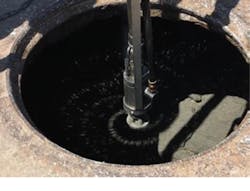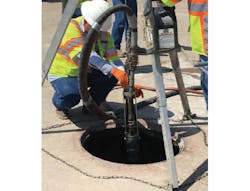LAREDO, TEXAS, founded in 1755, is a particularly old city. With a population of 250,000 it’s also one of Texas’ biggest cities, and is currently the fastest growing. This growth puts significant stress on the city’s aging—in places antique—sewer infrastructure.
“We have 700 miles of pipe in our sanitary sewer network, half clay and half PVC,” says Angel Leon. “PVC and some new clay was installed in the 80s and 90s, but much of the clay in the downtown area is over a hundred years old.”
Leon is Laredo’s Wastewater Collection Superintendent, a position he has held for ten years. During his tenure, manhole maintenance and rehabilitation have been a particular focus for him, for several reasons. For one, he’s responsible for 12,000 manholes – 70% are concrete and brick, with the remaining in fiberglass – and many of them are as old as the rest of the system. And probably more importantly, mortar and concrete are special problems in Laredo… and in most of Texas. “Texas is mostly flat, and usually warm, up to 105º degrees most summer days,” Leon explains. “And that means we, and the rest of the state, have some of the highest levels of H2S in the nation.” “H2S” is hydrogen sulfide, a well-known problem in sewers—it’s toxic and corrosive, can be explosive and flammable, and it’s a definite threat to sewer pipe integrity and to maintenance workers who have to enter sewers.
Hydrogen sulfide is the colorless gas, smelling of rotten eggs, that forms in swamps and other places where organic matter rots in warm, turbulent water with low oxygen levels. Sanitary sewers obviously present good conditions for H2S formation, and the conditions in Laredo are about perfect. The water is warm year round, nearly flat sewer networks keep pipes wet and slightly turbulent, and of course all sewers tend to be low on oxygen.
H2S is bad in itself, but it’s even worse as a food source for colonies of Thiobacillus bacteria, which thrive on hydrogen sulfide gas. The colonies, which can be huge, consume the gas and excrete sulfuric acid (technically, H2SO4) —some strains of Thiobacillus can thrive in acid concentrations as high as 7-percent. And in a matter of months, sulfuric acid can absolutely murder mortar and concrete, turning them into crumbly calcium sulfate, or gypsum (which is literally more like drywall than concrete). The process is called microbiologically-induced corrosion, or MIC. In Laredo, that meant catastrophic manhole failures used to be almost routine. “After one hurricane, we had five fail in a single day,” says Leon.
For many years, to both prevent and rehabilitate failed sewers, Laredo employed a two-part process. After cleaning and dewatering, manholes would first be rehabilitated structurally with spraycasted concrete that was then troweled smooth by workers entering the manhole. Then, two days later after curing, the new concrete was coated with epoxy to protect against sulfuric acid secreted by the Thiobacillus bacteria. This process is effective, but it presents some risk. The spraycasting and troweling required confined space entry (CSE), which requires trained workers and certification, not to mention the inherent danger to workers. And epoxy also requires CSE to apply and to inspect closely, and is only effective if it is applied perfectly; even a small gap in coverage—a pinhole is enough—can be exploited by Thiobacillus, which will form colonies invisibly behind the epoxy.
Laredo initially used contractors for manhole rehabilitation, but Leon eventually formed a crew focused mainly on manhole rehabilitation and other sewer repair projects. “To do epoxy well, you kind of have to love it,” he explains. “Contractors would usually apply it well, but not always, and we would sometimes see failures within six months. We had better success doing it ourselves, but even we had to go back sometimes.”
And there matters stood until 2016, when Leon discovered, and decided to try, the Permacast process. Permacast is an established and proven technology from AP/M Permaform that lowers a bi-directional, precisely controlled, spincaster into manholes to apply thin layers of high-strength fine aggregate composite concrete (FACC) to manhole interiors. In Laredo, the new concrete is mixed onsite and includes an MIC-resistant admixture called ConShield.
One Less Step, and a Third Less Labor
“I met with the Permacast guys at a trade show, and they came down to Laredo to show me the system,” Leon says. “I asked for references, and was able to talk to big contractors who use the process and really like it.”
A one-step process that provided both structural repair and permanent corrosion resistance was certainly appealing, and in 2016 Leon decided to take the plunge. “We already had the cement pump we needed, and the crew, so it just made sense to try this out,” he says.
The structural aspects of the Permacast manhole rehabilitation depend on the process’s patented spincaster, and on MS-10,000, the FACC that relies on precisely graded quartz sands, non-metallic fibers, and other complex admixtures to achieve a unique blend of strength and other desirable properties that make it a uniquely excellent choice for manhole rehabilitation. Norman (Ed) Kampbell, P.E., President of Rehabilitation Resources Solutions and a consultant to the underground construction sector, says, “The engineering sophistication of these FACCs should not be taken lightly by the design engineering community,” says Kampbell. “And it’s not just the strength characteristics, which dramatically exceed those of most concrete products. Low permeability, good freeze/thaw characteristics, the right thixotropy and thin shell toughness—AP/M Permaform has really got all these right with these products, making them a great choice for sewer structures.”
“Thin shell toughness” is important; it means that Laredo’s rehab crew can apply a very thin layer of MS-10,000—“We try for something between a half and one inch,” says Leon—in just three or four passes with the Permacast spincaster. This couldn’t be done with a handheld concrete sprayer; the winch-supported spincaster head is lowered into and withdrawn from manholes at precise speeds that keep layers even, and the bi-directional (spins both ways) application guarantees that the coverage isn’t compromised by gaps or ‘shadows’ due to projections or depressions in the original manhole—this is especially helpful in brick manholes.
ConShield, a unique admixture that is mixed directly into concrete mixed on rehabilitation sites, provides corrosion resistance. It’s a highly charged cationic polymer that makes cured concrete deadly to bacteria’s cell structure. Because it becomes an integral part of the concrete matrix, it provides permanent corrosion resistance that doesn’t wash or chip off and, for the same reason it’s non-toxic to humans and animals. Thiobacillus colonies don’t form, and this prevents the production of sulfuric acid.
Laredo first used Permacast to repair ten manholes, which have now been in service for two years. “We keep inspecting them, and they continue to hold up with no problems at all,” says Leon. His department now rehabilitates about 100 manholes annually with the process and, “I’d like to expand to 200, if possible.”
The workflow is very efficient, compared to the former two-step process. “We power wash the manholes, then immediately apply the MS10,000 with the spincaster,” says Assistant Superintendent Raymond Martinez. “That only takes three hours, and since cure times are now just six to eight hours, the manhole is back in service quickly. We can do three a day if we want to.”
Notably, confined space entry has been nearly eliminated, making this chore much safer for the maintenance crew. Laredo’s own crew, using the Permacast process, now does nearly all manhole repairs. “Once in a great while, if a manhole is in really bad shape, we’ll still call on contractors,” Leon says. “But frankly, it’s been a year since that happened, and we may not need them again.” Laredo schedules manhole work with their GIS, and seems to be getting on top of the problem, with no recent manhole failures, and good performance from all Permacast repairs to date.
Cost savings are significant. “Time and costs are about one third what they used to be, allowing us to do a lot more of this work annually,” In Laredo, using Permacast for manhole rehabilitations has been simpler, more cost-effective, faster and more efficient and, don’t forget, safer for workers. No wonder Leon says, “I don’t think we’ll ever stop using them.”
Editor's Note: Scranton Gillette Communications and the SGC Infrastructure Group are not liable for the accuracy, efficacy and validity of the claims made in this piece. The views expressed in this content do not reflect the position of the Roads & Bridges' Editorial Team.

